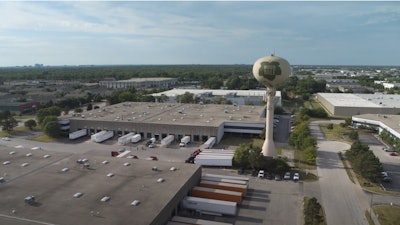
It’s difficult enough for any company – let alone distributor – to try to navigate a new and endlessly shifting world of tariffs in just a few short weeks.
But for Optimas Solutions, things get even more complicated: the suburban Chicago-based fastener and Class-C components distributor also has manufacturing facilities and engineering services — not to mention a footprint of 29 locations spanning nine countries across the globe.
Those challenges meant that the company had to try to get ahead of any number of potential scenarios and pitfalls. Daniel Harms, the company’s Americas CEO, says a “cross-functional team” began meeting every day starting in February in what has become Optimas’ de facto “tariff war room.”
What resulted from those efforts, he says, is an emphasis on communication, partnership and providing solutions — from making sure parts are coded properly, to shifting parts sourcing altogether, to bolstering the company’s domestic manufacturing.
Harms recently spoke with Industrial Distribution about some of the challenges posed by tariffs — and how the current landscape also provides Optimas with an opportunity to “do what we do best.”
This interview has been edited for length and clarity.
Industrial Distribution: How have tariffs – or, at least, the prospect of them – affected Optimas as a whole so far?
 Daniel HarmsOptimas Solutions
Daniel HarmsOptimas Solutions
ID: Are there any particular areas or product lines that are more affected than others that you’re seeing?
DH: We’re seeing customer uncertainty with forward-looking projections across most of our verticals carrying on throughout the remainder of the year. I think what was once projected to be a strong half two [of the year] leading to a booming ‘26 is now bathed in uncertainty.
We’re working with both our customers and our suppliers to use the best information available to make the best balanced decisions today until a more clear picture arrives on where things settle.
ID: I know it’s early, but what steps have you taken so far to kind of mitigate what we might see from tariffs moving forward?
DH: Optimas formed a cross-functional team that’s been meeting daily since February to address different scenarios in this dynamic landscape.
Our tariff war room, of sorts, is probably one of the most lively places in the company right now.
I believe our people really are one of our biggest differentiators, and the thought leadership that this team has really brought forth has been second to none.
I think as a full-service distributor, Optimas is well-positioned to offer solutions to help mitigate the impact of these costs to the fullest extent possible, and we’re really trying to use every tool in the toolbox right now to present options to customers — ranging from utilizing our global reach and database [for] countries that are less impacted to source parts from; expanding manufacturing capacity to be able to meet the increasing onshoring demand that we’re seeing flow in; and then really leveraging intel to ensure parts are properly coded to minimize unnecessary tariffs, to name a few. Just for a little context, our manufacturing in Wood Dale [Illinois] is seeing a 400% increase in quoting activity this last quarter compared to the same time period last year.
The reality, though, is many of these mitigating steps take time to get into place.
ID: Has it affected pricing at this stage for any of your product lines?
DH: As we think about conversations we’re having with customers internally, we talk a lot about how we provide value to our customers — and, as I said in the beginning, bringing options to our customers that allow them to mitigate the impact of tariffs has been a major way we’re trying to create value out of a volatile situation. In order to do that, we’ve tried to use the knowledge capital that the team has put work into [and] completed to date, and we’ve engaged almost 100% of our customers at this point to work on the right strategy given the operating landscape that we find ourselves in today. I think many of our customers have openly stated these costs are being passed on to the end customer and, to that end, we’re trying to navigate the cost pressures of today, while, in parallel, looking for those ways to offset them in the future. And that’s really our commitment to our customers, and the partnership that we’re expecting from our suppliers.
ID: You talked a little bit about presenting options, solutions to your customers; what’s the response been from them, and what are their primary concerns at this stage?
DH: I think for our customers, what we’re saying is partnership, right? And I think they’re looking for the best information that we can provide them in many ways. As they’re experiencing potential increases from a variety of suppliers, they’re trying to look for: how do they address and attack this in the most advantageous way for them? Because if they’re going to look at reshifting the geographic landscape or potentially moving to different countries, they don’t want to have to do engineering work for 10 different suppliers. They want to go for one particular design and look at the impacted area. So the information that we’ve been able to provide them is really allowing them to try to look at where the biggest opportunities are for them.
I think greater communication is one of the key things that we’re really engaging in: probably weekly meetings with some customers, certainly monthly meetings with most customers as we continue to evaluate what as we all know is a very dynamic and changing landscape. We are hearing from most of them that, again, demand signals are uncertain. And I think a lot of people are waiting in the next 30, 60, 90 days to see how this plays out.
I think where we’re trying to focus is really on, what are those “no regret” decisions? Things that are the right thing to do, absent tariffs, that still help in the tariff landscape that we find ourselves in.
ID: Shifting over to your suppliers’ side: how have you reached out to them since this all started, and what have you heard from them in response?
DH: We launched an initiative to gather facts from our suppliers, to determine the full impact of these tariffs on them and to help them with possible changes that they can make to minimize the impact of the tariffs and also increase part availability. I think it’s safe to say today that there’s a much better understanding of HSC codes and [other] certifications that many people have than they did earlier this year. And we’ve really been pleased with the collaboration that we’ve seen from our supply base.
I think the information-sharing has really been terrific, and we’ve received all the information that we’ve requested from at least 85% of our supply base at this point — really demonstrating a real desire to partner as we work through this. And we have more information coming in daily, so we expect to get 100% compliance with this.
The landscape is changing what seems like daily right now, and anyone drawing conclusions from what we think we know today is really just guessing — but I think, from our position, the companies that have the best information to act on will really be the first ones that can pivot and [see] what likely plays out on the short-, medium- and long-term horizon.
ID: Shifting to Optimas itself: you are, of course, a global company. You have offices all over the world. How have these changing circumstances affected those branches? I know you’re the CEO of Americas, so maybe it’s not your exact purview in the company, but can you talk a little bit about how these changes have affected those locations, and how they might interact with Optimas’ U.S. facilities?
DH: We stay connected. [Optimas CEO, International] Mike Tuffy and I stay connected frequently on that landscape. I think our international locations are facing similar challenges, right? I think the landscape in each country is different, but there’s no question that this has really had a global impact. We’re seeing this show up differently based on the region or country, but I think the reality is there’s some short-term volume declines in some countries, while creating new opportunities in others. In many cases, as you said, as a global company, Optimas is insulated by the overall demand shift, but country by country, we’re certainly seeing ups and downs.
ID: What are some next steps, if any, that you might be looking at as we move along here in these next few weeks or months?
DH: I think the way I’d answer that is we’re staying informed, we’re staying active and we’re staying nimble. We’re focused on both today and tomorrow, because both are going to be important.
And, as I said earlier, we’re really at our best when we’re leveraging our people’s talents to bring together those customer needs and supplier opportunities, and where that overlap occurs is where value gets created. And I think that’s where we find ourselves today.






















